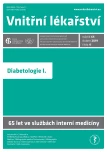How well we treat with insulin in the Czech Republic and in the Slovak Republic A summary of results and comments on the original Czech-Slovak DIAINFORM study
Authors:
Jan Brož 1; Denisa Janíčková Žďárská 1; Jana Urbanová 2; Viera Doničová 3; Emil Martinka 4; Milan Kvapil 1
Authors‘ workplace:
Interní klinika 2. LF UK a FN Motol, Praha
1; Centrum pro výzkum diabetu, metabolismu a výživy, II. interní klinika 3. LF UK a FNKV, Praha
2; Human-Care s. r. o., Diabetologická, interná a metabolická ambulancia, Košice, Slovenská republika
3; NEDÚ, Ľubochňa, Slovenská republika
4
Published in:
Vnitř Lék 2019; 65(4): 279-283
Category:
Overview
Despite the continuously improving treatment options, many patients with type 1 (T1DM) and type 2 diabetes (T2DM) still do not achieve the recommended treatment goals. The article provides summary and commentary of the results of DIAINFORM study focused on the level of metabolic control in T1DM and T2DM patients treated with insulin in the Czech and Slovak Republics. The overall percentage of patients with HbA1c 3 mmol/mol in the T1DM group was 29.9 % and in the T2DM group was 33.4 %.
Keywords:
metabolic control
Sources
-
Brož J, Janíčková Žďárská D, Urbanová J et al. Current level of glycemic control and clinical inertia in subjects using insulin for the treatment of type 1 and type 2 diabetes in the Czech Republic and the Slovak Republic: results of a multinational, multicentre observational survey (DIAINFORM). Diab Therapy 2018; 9(5): 1897–1906. Dostupné z DOI: <https://doi.org/10.1007/s13300–018–0485–2>.
-
Brož J, Janíčková Žďárská D, Urbanová J et al. An international, multicenter, observational survey to evaluate diabetes control in subjects using insulin for the treatment of type 1 and type 2 diabetes mellitus in the Czech Republic and Slovakia: study protocol for a cross-sectional survey. Open Access Journal of Clinical Trials 2016; 8: 13–20. Dostupné z DOI: <https://dx.doi.org/10.2147/OAJCT.S103459>.
-
[American Diabetes Association]. 6. Glycemic Targets. Diabetes Care 2017; 40(Suppl 1): S48-S56. Dostupné z DOI: <http://dx.doi.org/10.2337/dc17-S009>.Erratum in Erratum. Glycemic Targets. Sec. 6. In Standards of Medical Care in Diabetes-2017. Diabetes Care 2017; 40(Suppl. 1); S48-S56. [Diabetes Care. 2017].
-
Inzucchi SE, Bergenstal RM, Buse JB et al. Management of hyperglycaemia in type 2 diabetes: a patient-centered approach. Position statement of the American Diabetes Association (ADA) and the European Association for the Study of Diabetes (EASD). Diabetes Care 2015; 38(1): 140–149. Dostupné z DOI: <https://doi.org/10.2337/dc14–2441>.
-
Anděl M, Grzeszczak W, Michalek J et al. A multinational, multi-centre, observational, cross-sectional survey assessing diabetes secondary care in Central and Eastern Europe (DEPAC Survey). Diabet Med 2008; 25(10): 1195–1203. Dostupné z DOI: <http://dx.doi.org/10.1111/j.1464–5491.2008.02570.x>.
-
Pablos-Velasco P, Parhofer KG, Bradley C et al. Current level of glycaemic control and its associated factors in patients with type 2 diabetes across Europe: data from the PANORAMA study. Clinical Endocrinology 2014; 80(1): 47–56. Dostupné z DOI: <http://dx.doi.org/10.1111/cen.12119>.
-
Selvin E, Parrinello ChM, Daya N et al. Trends in Insulin Use and Diabetes Control in the U.S.: 1988–1994 and 1999–2012. Diabetes Care 2016; 39(3): e33-e35. Dostupné z DOI: <http://dx.doi.org/10.2337/dc15–2229>.
-
Riddle MC, Bolli GB, Ziemen M et al. New insulin glargine 300 units/mL versus glargine 100 units/mL in people with type 2 diabetes using basal and mealtime insulin: glucose control and hypoglycemia in a 6-month randomized controlled trial (EDITION 1). Diabetes Care 2014; 37(10): 2755–2762. Dostupné z DOI: <http://dx.doi.org/10.2337/dc14–0991>.
-
Rosenstock J, Hollander P, Bhargava A et al. Similar efficacy and safety of LY2963016 insulin glargine and insulin glargine (Lantus®) in patients with type 2 diabetes who were insulin-naïve or previously treated with insulin glargine: a randomized, double-blind controlled trial (the ELEMENT 2 study). Diabetes Obes Metab 2015; 17(8): 734–741. Dostupné z DOI: <http://dx.doi.org/10.1111/dom.12482>.
-
Riebenfeld D, Spirk D, Mathis A et al. Treatment intensification with insulin glargine in patients with inadequately controlled type 2 diabetes improves glycaemic control with a high treatment satisfaction and no weight gain. Swiss Med Wkly 2015; 145: w14114. Dostupné z DOI: <http://dx.doi.org/10.4414/smw.2015.14114>.
-
Reach G, Pechtner V, Gentilella R et al. Clinical inertia and its impact on treatment intensification in people with type 2 diabetes mellitus. Diabetes Metab 2017; 43(6): 501–511. Dostupné z DOI: <http://dx.doi.org/10.1016/j.diabet.2017.06.003>.
Labels
Diabetology Endocrinology Internal medicineArticle was published in
Internal Medicine

2019 Issue 4
Most read in this issue
- Primary and secondary insulin resistance
- Current view of treatment of hypoglycemia
- Diabetes mellitus 1. typu: etiologie a epidemiologie
- Driver medical fitness and diabetes mellitus: legislative changes in 2018 and a summary of health aspects
